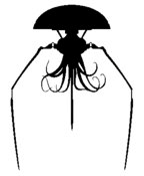
Invaders from Mars!

Invaders from Mars!
The Lasting Influence of H.G. Wells and His Martians
Kevin J. Anderson
The War of the Worlds changed my life and made me into a writer, so this Foreword will be more personal than academic.
When I was an imaginative five-year-old kid, living in a small Wisconsin town with little to do, one evening my parents let me watch the George Pal film version of The War of the Worlds. It’s not often you can use the words “agog” or “gobsmacked,” but there’s no other way to describe my reaction to the Martian invasion, the cylinders and the heat ray, the terrifying and intense scene down in the dark basement, how all of humanity seemed lost against these invincible aliens, until in the end they were felled by lowly Earth bacteria.
That story seized my imagination like nothing else ever had. I couldn’t sleep that night. The next day, afire with that story, I found a blank notepad and with my childish artistic abilities I sketched out key scenes from the movie and laid them out on the floor, retelling the tale of the War of the Worlds to anyone who would listen. I used pictures because I didn’t yet know how to write.
It was the pivotal moment that convinced me I wanted to tell stories like H.G. Wells did, that I wanted to be a writer.
Several years later, my parents realized that our household didn’t have enough books, and they rectified that situation by purchasing the Airmont Classics Library, one hundred classics of literature in cheap paperbacks with tiny print—including many of the works of H.G. Wells. One of the first books I snagged from that collection was The War of the Worlds. I was eight years old, equally captivated by the story but intrigued to find that it was different from the movie. After reading it avidly, I also devoured The Time Machine, The Invisible Man, The Island of Dr. Moreau, The Food of the Gods. Wells’s ideas fired my imagination.
A year later, on my first trip to the big city (Milwaukee, Wisconsin), we went to a shopping mall where I entered a B. Dalton Bookseller, the largest bookstore I had ever seen. My mom told me I could pick one book to buy—a nearly impossible conundrum. In the science fiction section, I found a 1970 paperback reissue of H.G. Wells’s obscure novel Star Begotten by Leisure Books. The cover showed a hideous-looking alien monster looming over an innocent human baby. That was the one for me!
Over the next month or so I worked my way through the difficult prose (I was nine). Star Begotten was one of Wells’s later novels, written at a time when he was more concerned with social philosophy and utopian thoughts than with monsters and action. Even so, I realized that this story also dealt with a Martian invasion, but of a different kind. Because the Martians knew they could not tolerate Earth’s microorganisms, they launched a psychic invasion instead. Star Begotten was, in fact, H.G. Wells’s own actual thematic sequel to The War of the Worlds, written almost forty years later.
In college, I continued my interest in the history of science fiction, and that’s when I discovered that another sequel to The War of the Worlds had also been written, almost immediately after the initial publication of Wells’s novel. American astronomer Garrett P. Serviss wrote Edison’s Conquest of Mars, an unauthorized though quite popular yarn published in America (happily evading copyright laws) in the New York Journal, in which Thomas Edison heads off to fight the Martians and thwart another invasion—after cameos from Queen Victoria, the Kaiser, and the Mikado. It’s clunky and pulpy, but still a fun yarn, and a part of The War of the Worlds history.
H.G. Wells was an enormous influence on my imagination, and I began to use some of his ideas in my own stories. I reread his novels regularly, and each time I am impressed in new ways for his vision and his storytelling. Now, half a century after I first saw that movie as a wide-eyed kid, I have published 165 novels with 23 million copies in print in 31 languages. (One of those novels, Mr. Wells & the Martians, features H.G. Wells himself as a main character, along with his second wife Jane as well as T.H. Huxley, Percival Lowell, and Dr. Moreau.)
I can trace my writing and my career all back to that pivotal event, that one story—The War of the Worlds.